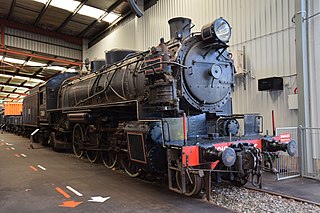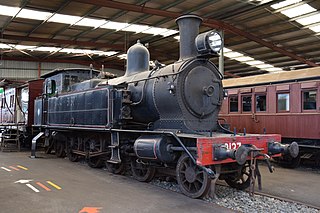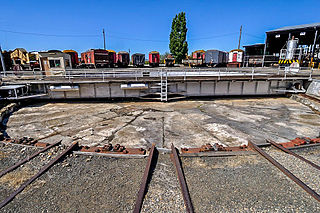| New South Wales Z25 class | |||||||||||||||||||||||||||||
|---|---|---|---|---|---|---|---|---|---|---|---|---|---|---|---|---|---|---|---|---|---|---|---|---|---|---|---|---|---|
 | |||||||||||||||||||||||||||||
| |||||||||||||||||||||||||||||
| |||||||||||||||||||||||||||||
| |||||||||||||||||||||||||||||
| |||||||||||||||||||||||||||||
The New South Wales Z25 class was a class of 2-6-0 steam locomotives operated by the New South Wales Government Railways of Australia.
| New South Wales Z25 class | |||||||||||||||||||||||||||||
|---|---|---|---|---|---|---|---|---|---|---|---|---|---|---|---|---|---|---|---|---|---|---|---|---|---|---|---|---|---|
 | |||||||||||||||||||||||||||||
| |||||||||||||||||||||||||||||
| |||||||||||||||||||||||||||||
| |||||||||||||||||||||||||||||
| |||||||||||||||||||||||||||||
The New South Wales Z25 class was a class of 2-6-0 steam locomotives operated by the New South Wales Government Railways of Australia.
In the late 1870s, only 11 of the 82 goods locomotives in service on the Southern and Western lines of the New South Wales Government Railways had a leading truck. The balance had a wheel arrangement of 0-6-0. To provide a more suitable locomotive for use over the 8 chain (161 m) radius curves of the Blue Mountains line, it was decided to incorporate a Bissell pony truck on an improved version of the A93 class, previously known as B class. [1]
Beyer, Peacock & Company prepared a design which was considered to be in advance of British contemporary practice. The first twenty 205 class entered service in 1882. [1]
The new engines were found to be more sluggish than the 93 class when getting away with a load, but pulled decidedly better when running tender first. Following tests on the Blue Mountains, Commissioner Goodchap recommended the installation of 50 ft. (15.25 m) turntables at Sydney, Bathurst and Goulburn which were required to turn the new locomotives. Four were allocated to the then isolated Northern network. [1]
At that time, there were thirty 93 class locomotives on order. As Locomotive Engineer W. Scott considered the new 205 class better suited to his requirements, the order was amended to thirty 205 class locomotives, but with some minor improvements. These entered service in 1883/84, eight being allocated to Northern network. [1]
Both batches were found to be prone to slipping and an increase of driving axle load was deemed to be necessary.
A further 20 arrived in 1885, five of which going to the Northern system. This last batch had cabs with steel cutaway sides, an improvement on the open cabs of the earlier batches. [1]
In the late 1880s, the class were based at Sydney, Goulburn, Penrith, Bathurst, Newcastle, Murrurundi and Armidale. [1]
From February 1901, all of the class were fitted with larger Belpaire boilers which increased their weight and also increased the heating surface, matters identified as deficient in William Thow' report of 1889. [2] At the same time, wooden cabs replaced the open cabs of the earlier batches. [1]
With the arrival of the T524 class locomotives in 1896, main line work began to be assigned to these newer classes and the 205 class were relegated to lighter branch lines. [3] In 1923, 2531 and 2534 were fitted with superheaters after accidents. [4] As part of the 1924 reclassification scheme, all 70 were reclassified as the Z25 class and renumbered 2501 to 2570. [1]
During the years of the Great Depression, many of these locomotives fell into derelict condition after becoming due for overhaul. Some were used during the load testing of the Sydney Harbour Bridge in 1932. [3]
Two identical locomotives were built for the Midland & South Western Junction Railway, England in 1895 and 1897. [5]
Two have been preserved:

The C38 class was a class of steam locomotive built for the New South Wales Government Railways in Australia.

The New South Wales 42 class was a class of diesel locomotives built by Clyde Engineering, Granville for the New South Wales Department of Railways in 1955/56.

The 421 class are a class of diesel locomotives built by Clyde Engineering, Granville for the Department of Railways New South Wales in 1965/66. These mainline locomotives were a follow on from the 42 class. The 421s retained the classic bulldog nose as with the other Clyde built GM and S locomotives at one end, but featured a flat-cab at the other end. In this respect, they are unique amongst bulldog nose locomotives in the world.

The 48 Class is a class of diesel locomotives built by AE Goodwin, Auburn for the New South Wales Department of Railways between 1959 and 1970. Once the most ubiquitous locomotive in New South Wales, Australia, it is based on Alco frames and prime movers, using General Electric electrical equipment. The South Australian Railways 830 and Silverton Rail 48s classes are of a very similar design.

The New South Wales C36 class was a class of two-cylinder, simple, non-condensing, coal-fired superheated, 4-6-0 express passenger steam locomotives built by Eveleigh Railway Workshops and Clyde Engineering for the New South Wales Government Railways in Australia.

The 59 class is a class of steam locomotive built by Baldwin-Lima-Hamilton Corporation for the New South Wales Government Railways of Australia.

The X200 class were a class of rail tractors introduced in 1963 and operated by the New South Wales Government Railways of Australia. They were a development of the smaller and less numerous X100 class. The X200 class remained in service until 1990 when they were either withdrawn or sold off to private companies, and some remain operational today.

The New South Wales D57 class was a class of 4-8-2 steam locomotives built by Clyde Engineering for the New South Wales Government Railways in Australia. The tenders were built by Mort's Dock & Engineering Company.

The New South Wales Z19 class was a class of 0-6-0 steam locomotives operated by the New South Wales Government Railways of Australia.

The C30 class is a class of steam locomotives built by Beyer, Peacock & Company and Eveleigh Railway Workshops for the New South Wales Government Railways (NSWGR) of Australia.

The New South Wales D50 class was a class of 2-8-0 steam locomotives operated by the New South Wales Government Railways in Australia.

The New South Wales AD60 class were Beyer-Garratt patent articulated four-cylinder, simple, non-condensing, coal-fired superheated, 4-8-4+4-8-4 heavy goods steam locomotives built by Beyer, Peacock & Company for the New South Wales Government Railways in Australia.

The D58 class was a class of steam locomotives built by the New South Wales Government Railways in Australia. They were built with the 4-8-2 wheel arrangement.

The 70 class were a class of diesel-hydraulic locomotives built by Commonwealth Engineering, Granville for the New South Wales Department of Railways in 1960–61. They were ordered to replace steam locomotives at Port Kembla.

The 73 class is a diesel-hydraulic locomotive built by Walkers Limited, Maryborough for the New South Wales Department of Railways between 1970 and 1973.

Locomotive 3642 is a two-cylinder, simple, non-condensing, coal-fired superheated, 4-6-0 36 class express passenger steam locomotive built for the New South Wales Government Railways in 1926 by Clyde Engineering. It is one of three 36 class locomotives that were preserved.

Broadmeadow Locomotive Depot was a large locomotive depot consisting of two roundhouse buildings and associated facilities constructed by the New South Wales Government Railways adjacent to the marshalling yard on the Main Northern line at Broadmeadow. Construction of the locomotive depot at Broadmeadow commenced in 1923 to replace the existing crowded loco sheds at Woodville Junction at Hamilton, with the depot opening in March 1924. It was added to the New South Wales State Heritage Register on 2 April 1999.

The X10 class is a class of steam locomotives previously operated by the New South Wales Government Railways of Australia.

The Goulburn Rail Heritage Centre is located at the heritage-listed former railway workshops in Goulburn, New South Wales, Australia, on the Main Southern railway line. Now a museum, it is also known as the Goulburn Rail Workshop and Goulburn Roundhouse. The workshops were added to the New South Wales State Heritage Register on 2 April 1999. The workshops were saved from demolition by the Goulburn Locomotive Roundhouse Preservation Society and is now a museum open to the public with large collection of rolling stock and various exhibits, as well as privately owned locomotives and carriages with some commercial repair work happening on site.

Eighteen South Australian Railways K class (broad-gauge) locomotives were built by Beyer, Peacock and Company for the South Australian Railways (SAR) between 1878 and 1884. Despite having a fundamental design flaw that affected their original role as light-line passenger locomotives, they eventually performed shunting duties exclusively. They operated for six decades.
![]() Media related to New South Wales Z25 class locomotives at Wikimedia Commons
Media related to New South Wales Z25 class locomotives at Wikimedia Commons